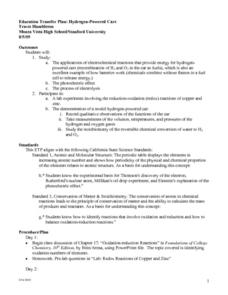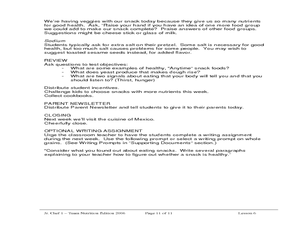Curated OER
Oxidation and Salt
Students study the reaction on iron in water, air, and sodium chloride. They create a situation that shows this process and gives them the opportunity to hypothesize what, why, and how. They keep records and do an oral and written ...
Curated OER
6260 Atoms Test
In these chapter test worksheets students will multiple choice questions on atoms. Students will complete 77 questions on atoms to complete the chapter test.
Curated OER
Physical and Chemical Change of Six White Substances
Young scholars investigate chemical and physical changes in reactions. In this chemical and physical change lesson plan, students mix 6 different white substances with water, vinegar and iodine. They make hypotheses about each substance...
Curated OER
What Influences Reaction Rate?
Students study reaction rates, what determines how fast a reaction happens and how the chemical changes occur. In this reactions lesson students complete a lab where they use Alka-Seltzer to observe reaction rate and create a graph...
Curated OER
Buoyant Boats
Students design and construct a boat out of aluminum foil and a few other simple materials. The boats then be tested by floating them in water, then adding mass until they sink. They explore the various shapes of boat construction.
Curated OER
Water, Water Everywhere (Pond Animals)
Second graders examine the characteristics of animals who live in a pond environment. In groups, they describe the various stages in the life of a frog and identify the characteristics of other pond animals. Using this information,...
Curated OER
Hot Cans and Cold Cans
Learners investigate the physics of heating and cooling through conduction, convection, and radiation. Working in groups, they determine the best way to cool a can of water and warm a can of water. Temperature is taken at five minute...
Curated OER
Hydrologic Cycle Scavenger Hunt
Students explore the water cycle using educational resources. In this water cycle lesson, students use a global climate DVD to complete a scavenger hunt on the hydrologic (water) cycle.
Curated OER
Water Cycle
Ninth graders explore ways water moves through various reservoirs on Earth, examine how human activities change water cycle, investigate substances present in water that indicate human activity, and discuss how understanding water cycle...
Curated OER
Hydrogen Powered Cars
Students apply the principles of chemistry to investigate the concept of how a hydrogen powered car works. They study the electrochemical reactions that provide the energy source. Students also record observations in the functioning of a...
Curated OER
Alchemists' Theory of the Elements
In this alchemy worksheet, students read about the early thoughts of alchemists regarding elements. Students are given an experiment done by an alchemist during the Middle Ages and they answer three questions about the experiment knowing...
Curated OER
Sweet Candy Comets
Fourth graders use candy to make a comet. In this lesson, 4th graders examine the role comets have played throughout history, students watch NASA videos about comets and complete the lesson by making an edible model of a comet. This...
Curated OER
Scrambled Eggs Anyone?
Learners listen to Nursery Rhymes highlighting GRAVITY, pull ropes during a Rope Pull Activity and even drop eggs from a height during a Gravity Contest. This is a fantastic lesson which highly motivates Students!
Curated OER
Mixture Mayhem
In this mixture worksheet, learners are given five mixtures and they determine if each is a mechanical mixture or a solution. They also identify the way each substance within the mixture can be separated from the others.
Curated OER
Animal Alphabet
Second graders identify animals with each letter of the alphabet. In groups, they create a PowerPoint presentation which shows the information they have collected about each one. Using all of this information, they create an animal...
Curated OER
What is the Attraction?
Second graders investigate the law of polarity. In this magnets instructional activity, 2nd graders discover how magnets are used in everyday life and which objects in our environment are magnetic. Students experiment with bar...
Curated OER
Water Vapor Equilibrium
For this chemistry worksheet, students complete 12 short answer questions and problems on water vapor equilibrium. They calculate equilibrium concentrations of reactants and products.
Curated OER
Eating Through the Metric System
Seventh graders convert measurements in recipes to metric measurements and prepare the food items. They create a metric measurement cookbook.
Curated OER
From Bats to Babies: Ultrasound
Students research and analyze sound waves and how an ultrasound works to image a baby in utero. They explore various websites, complete worksheets, and write a paragraph describing a demonstration they view in the classroom.
Curated OER
The Great Grizzly
Students generate questions about grizzly bears and use the Internet to research the answers. As a culminating activity, students create a life-size mural of a grizzly that is annotated with the information they've learned.
Curated OER
Salt: Up Close and Personal
Students predict, observe, and explain the details of salt as they view it under a variety of magnifications. They observe salt with the naked eye, and then under a hand lens, microscope, and the electron microscope.
Curated OER
Frosty the Snowman Meets His Demise: An Analogy to Carbon Dating
Students read and discuss an article about carbon dating, then participate in a hands-on lab to discover how carbon dating works. Students also write a letter to a friend explaining the process, and how archeologists use the process to...
Curated OER
Jr. Chef Club Super Snacks Lesson 6
Students explore healthy snacks. In this nutrition and cooking lesson, students observe and identify food groups on USDA's MyPyramid food guide. Students discuss how fiber helps our digestive system and follow a recipe using yeast to...
Curated OER
So You Think You're Tough
Fourth graders learn how to classify animals. For this invertebrates lesson, 4th graders discuss how we classify thinks into groups and move into a discussion about classifying animals. Students learn about the differences between...

























